10X
SPARKLING
ESTATE
SINGLE VINEYARD
TRAHERE
WINE LIBRARY
Wines
“The wines from this estate have become classier and classier with each passing year. Indeed, it’s fast heading for elite status.”
— CAMPBELL MATTINSON & GARY WALSH, WINE WRITERS
10X
10X wines are sourced from several vineyards on the Mornington Peninsula and are therefore a regional expression of each variety. All of our fruit is Estate grown and managed.
Estate & Sparkling
Our Estate wines are a barrel selection from our individual vineyards which are blended to create the best expression of Mornington Peninsula Pinot Noir and Chardonnay.
Single Vineyard
We produce Single Vineyard Pinot Noir and Chardonnay from our Estate vineyards – McCutcheon, Coolart Road, Judd and Wallis – which are 100% managed by our viticultural and winemaking teams.
These wines are produced from the highest performing blocks from each of these vineyards, harvested from small carefully selected parcels ensuring the clearest expression of their terroir.
”The Ten Minutes by Tractor range from the Mornington Peninsula always offers a choice of some of Australia’s finest single-vineyard chardonnays.”
— WINSOR DOBBIN, AUSTRALIAN WINE WRITER
Trahere
This is a new limited release wine that is inspired by our high density vineyard in Main Ridge, the culmination of many years of planning, hard work and passion.
"Sourced from the best vineyard sites – including some newer, very high-density plantings – it has remarkable intensity, concentration, and almost voluptuous dark fruit, but also superb finesse and length of flavour."
— MAX ALLEN, AUSTRALIAN FINANCIAL REVIEW
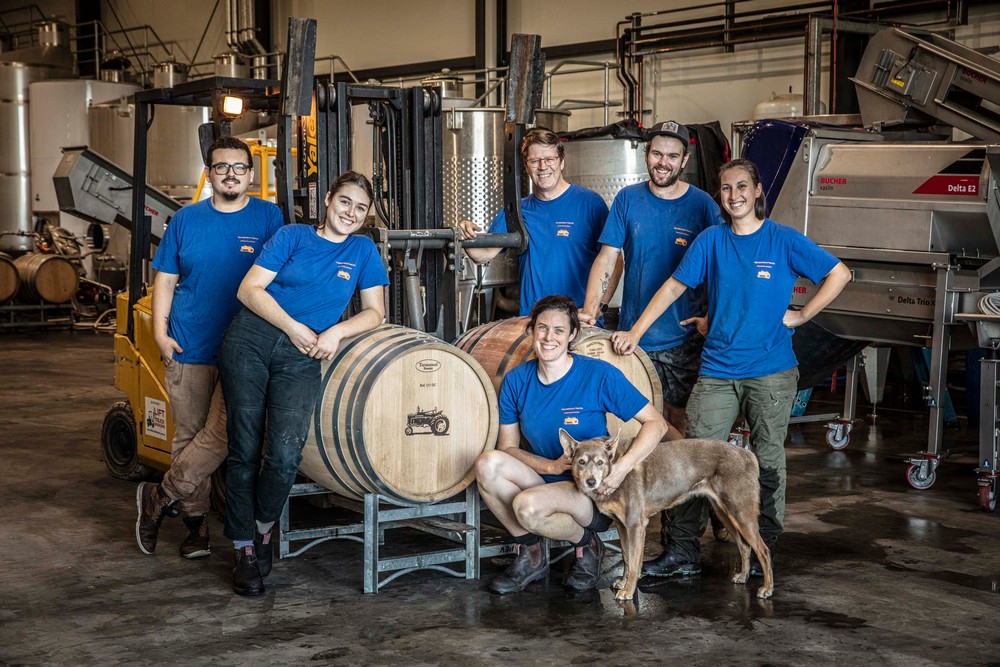
Winemaking and Viticulture
Our winemaking and vineyard teams are highly experienced and have worked in a number of wine regions in the old and new world. They have an in- depth understanding of every square metre of our vineyards and it is from this knowledge that we make and assemble each of our wines. Our low intervention approach to winemaking uses natural and traditional processes to enhance complexity, elegance and balance in our wines. This includes the use of indigenous yeasts in all our wines. We cultivate all our soils under vine mechanically and do not use herbicides. The cultivation of vineyard soils and use of sustainable vineyard practices are central to our vineyard management philosophy and belief that it preserves and promotes the natural terroir of our vineyards and produces superior wines.
We are heavily influenced by Burgundian winemaking traditions and philosophy; we choose to follow unhurried methods with our winemaking – this ancient craft and our own ambitions demand an artisanal perspective. Our wines are bottled under screwcap to prevent cork taint and random oxidation and to preserve the pristine characters of our wines.
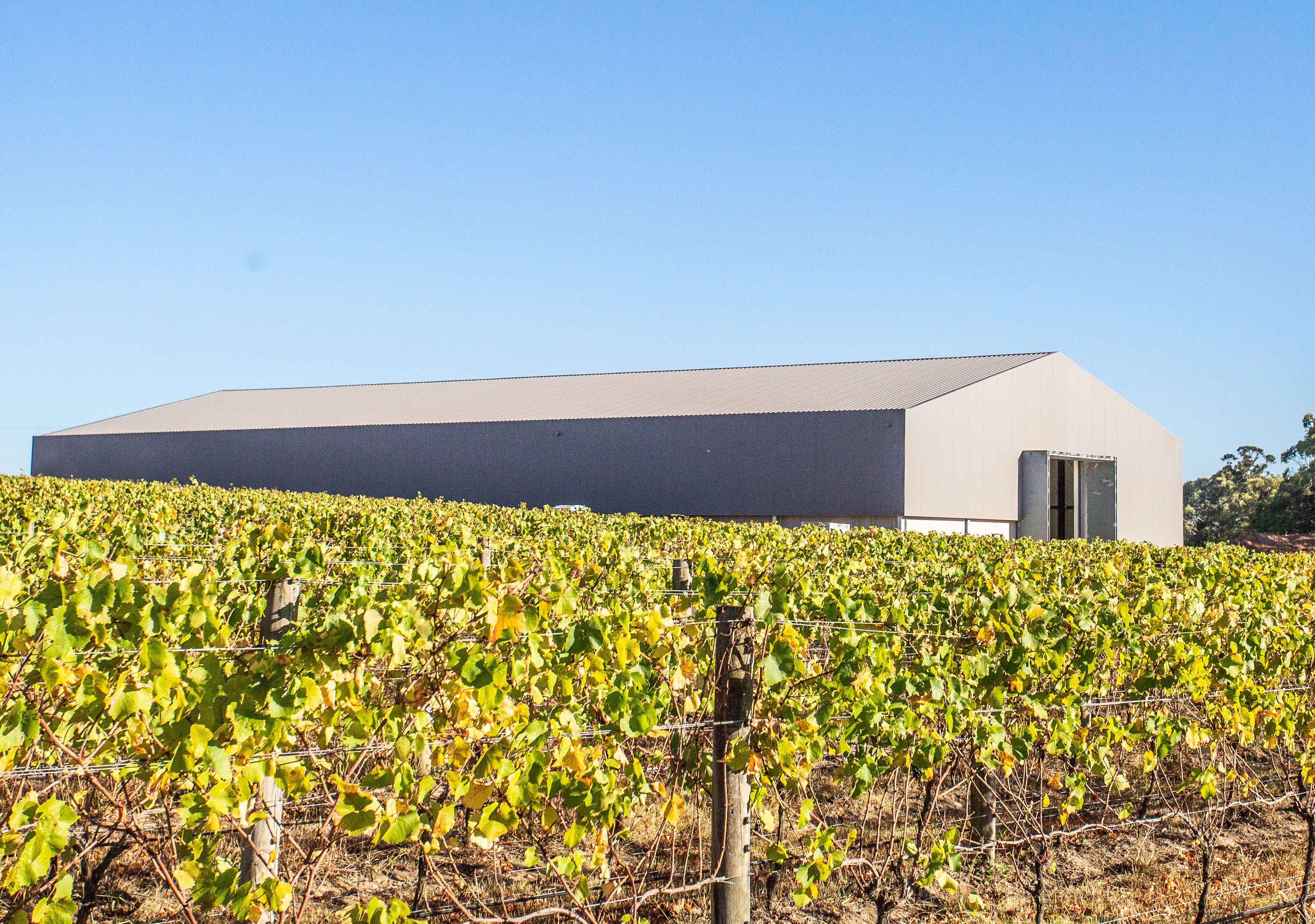
Wine Library
A collection of newsletters, vintage notes, releases & tasting notes from throughout the years
2024 |
2023 |
2022 |
2021 |
2020 |
2019 |
2018 |
2017 |
2016 |
2015 |
2014 |
2013 |
2012 |
2011 |
2010 |
2009 |
2008 |
2007 |
2006 |
2005 |
2004 |
2003 |
2002 |
2001 |
2000 |
2000 Vintage
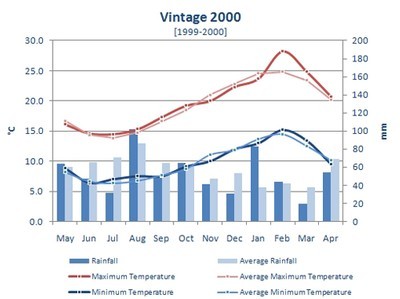
Main Ridge Pinot Noir
Budburst – 29 Aug
Flowering – 21 Nov
Veraison – 8 Feb
Harvest – 31 Mar
Budburst-harvest – 216 days
DORMANT INTERVAL [MAY – AUG]
Temperatures slightly above average; rainfall about 13% below average. Budburst excellent, good shoot development.
BUDBURST INTERVAL [SEP – NOV]
Temperatures very close to average; rainfall about 12% below average. Moderate flowering conditions, good growth, healthy canopies.
FLORAISON INTERVAL [DEC – JAN]
Temperatures close to average; rainfall well above average (24%) largely due to a wet January (82mm v 38mm avg). Fruit set average, moderate disease pressure.
VERAISON INTERVAL [Feb-Apr]
Temperatures well above average, our warmest Veraison Interval; rainfall 18% below average, March, leading up to harvest on 31st, was one of the driest in our records with about 50% of average rainfall (19mm v 38mm avg). Great ripening period with excellent flavours, low disease pressure.
Early budburst, but flowering, veraison and harvest were all almost exactly average resulting in a slightly longer than average hang time.
Wine quality was generally regarded as excellent; Langton’s rate it 9.
TASTING NOTES | SINGLE VINEYARD
2000 MCCUTCHEON CHARDONNAY
Fractionally deeper colour, headed more to yellowstraw; a quite powerful bouquet with a mix of nutty fig and more minerally aromas, then a palate which belies the colour, as it has less full-frontal fruit development, yet retains fruit sweetness.
88 | James Halliday
2003 Australian Wine Companion
2000 JUDD CHARDONNAY
Medium to full yellow; the bouquet has a mix of cashew, yellow peach, fig and subtle oak, the palate the best balanced of the three individual wines, with sweet peachy fruit, good acidity and good length.
91 | James Halliday
2003 Australian Wine Companion
2000 WALLIS CHARDONNAY
Medium to full yellow; the bouquet is rich and smooth, with hints of nut, smoke and fig; a big, solidly ripe palate with nutty melon flavours tightened up by acidity on the finish.
88 | James Halliday
2003 Australian Wine Companion
2000 MCCUTCHEON PINOT NOIR
Light to medium red-purple; the bouquet has plum, cherry and some savoury notes, the palate with clearly expressed plum and cherry fruit; less complex than the Judd Vineyard but with good structure. Subtle oak.
92 :: James Halliday
2003 Australian Wine Companion
2000 JUDD PINOT NOIR
Medium red-purple; sweet, complex strawberry and spice aromas lead into a stylish, light to medium bodied palate, with surprising intensity and length, a touch of dark cherry adding to the complexity of fruit flavours.
94 :: James Halliday
2003 Australian Wine Companion
2000 WALLIS PINOT GRIS
Rich, musky, full on, exotic styles as exemplified by the Ten Minutes by Tractor Wallis Vineyard Pinot Gris 2000. It’d be the wine the judges would want to take away with them to drink. Especially with a Thai green curry.
Tim White
Australian Financial Review
TASTING NOTES | 10X
2000 10X CHARDONNAY
Medium to full yellow-green, quite developed; complex fig, cashew and ripe peach aromas are followed by a full-bodied palate, again with fig, white peach and melon fruit; good balance and length.
92 | James Halliday
2003 Australian Wine Companion
2000 10X PINOT NOIR
Light red-purple; light, spicy/sappy/plummy aromas became increasingly fragrant and complex as the wine sat in the glass; the palate, while light bodied, has great texture and length, with a mix of sappy/savoury characters alongside strawberry, cherry and plum. Fully deserved its gold medal at the 2001 Victorian Wines Show; also demonstrates the danger of judging pinot noir by its colour.
94 | James Halliday
2003 Australian Wine Companion
2001 Vintage
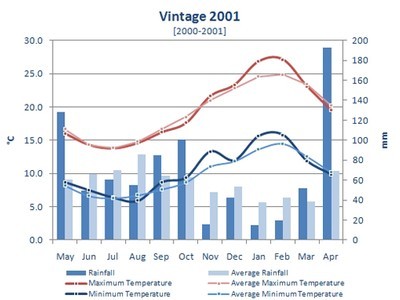
Main Ridge Pinot Noir
Budburst – 29 Aug
Flowering – 21 Nov
Veraison – 6 Feb
Harvest – 14 Apr
Budburst-harvest – 229 days
DORMANT INTERVAL [MAY – AUG]
Temperatures slightly below average; rainfall just above average. Budburst early with excellent growth.
BUDBURST INTERVAL [SEP – NOV]
Temperatures average though warmest minimum; rainfall 15% above average. Excellent flowering.
FLORAISON INTERVAL [DEC – JAN]
Temperatures above average and including our warmest ever January (26.8°C v 24.5°C); rainfall 37% below average, one of our driest floraison intervals. Fruit set excellent, good yield, good growth, and low disease preassure.
VERAISON INTERVAL [Feb-Apr]
Temperatures just above average mainly due to a hot February, March and April were just below average; after a dry February, rainfall well above average in March and, particularly, in April – 23 April 2001 experienced a “rainfall event”, 104mm in 24 hours (record daily rainfall); 29mm fell the day before, 30mm the day after. Harvest conditions mostly good throughout, although some late botrytis which spun out of control on crops left after 23 April. Early budburst, flowering and veraison were almost exactly average but harvest was almost 2 weeks later than average. Longest hang time, 21 days longer than average. Anything harvested before 22 April was fine, anything after was subject to huge disease pressure and lack of ripening. This was the vintage we produced a “sticky” from botrytis affected Chardonnay and Sauvignon Blanc. Langton’s rate it 8.
TASTING NOTES | SINGLE VINEYARD
2001 Judd Chardonnay
“Pale green gold in colour. An intense nectarine, spice, mineral and flint nose is followed by a rich, mouth filling palate with characters of citrus, white peach and nectarine with spicy well integrated oak. Finishes long and clean.”
TASTING NOTES | 10X
2001 10X Sauvignon Blanc
Light straw-green; a spotlessly clean, crisp bouquet falls predominantly in the grass/herb/mineral spectrum, but does have some riper nuances; the palate is correspondingly clean, firm and bright, lemony acidity providing an attractive spine.
89 :: James Halliday :: 2003 Australian Wine Companion
2001 Sparkling Allis
This sparkling wine was made in 2001 from a 50/50 blend of Chardonnay and Pinot Noir. Disgorged in December 2007, it spent almost 7 years on its lees.
94 | James Halliday
2003 Australian Wine Companion
2001 Sweet Allis
Named after the Judd Vineyard’s 1946 Vintage Allis Chalmers tractor, this unique dessert wine is made from botrylis affected Chardonnay (75%) and Sauvignon Blanc (25%)
TASTING NOTES | Estate/Reserve Wines
TASTING NOTES | 10X Wines
2002 Vintage
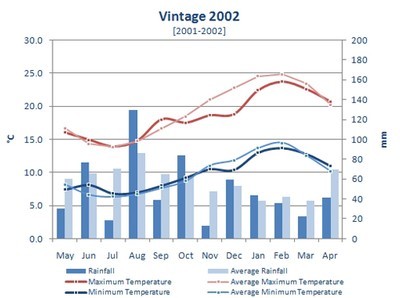
Main Ridge Pinot Noir
Budburst – 10 Sep
Flowering – 29 Nov
Veraison – 10 Feb
Harvest – 14 Apr
Budburst-harvest – 216 days
DORMANT INTERVAL [MAY – AUG]
Temperatures average; rainfall just below average. Good budburst with excellent growth.
BUDBURST INTERVAL [SEP – NOV]
Temperatures close to average; rainfall 23% below average. Incredibly poor flowering. some blocks set no fruit at all, average yields 1/3 of desired range (if harvested)
FLORAISON INTERVAL [DEC – JAN]
Temperatures below average, easily our coolest December and, overall, our coolest floraison interval; rainfall 13% above average. Very poor fruit set, coulure (berries do not set and shatter after flowering), a lot of hen & chicken.
VERAISON INTERVAL [Feb-Apr]
Temperatures just below average; rainfall 31% below average. Very good conditions for harvest, intense flavour development from very low yielding vines.
Average budburst, slightly late flowering but very late veraison (2 weeks later than average), however harvest was a week earlier than average. Short hang time, 5 days shorter than average.
Wines were good but yields negligible (2002 PN 0.5 t/ha). Langton’s rate it 6/Halliday 8.
TASTING NOTES | 10X WINES
TASTING NOTES | Estate/Reserve Wines
2003 Vintage
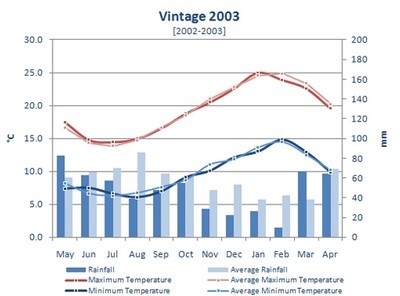
Main Ridge Pinot Noir
Budburst – 10 Sep
Flowering – 29 Nov
Veraison – 10 Feb
Harvest – 14 Apr
Budburst-harvest – 216 days
DORMANT INTERVAL [MAY – AUG]
Temperatures average; rainfall 14% below average. Slow start to budburst but shoots developed well.
BUDBURST INTERVAL [SEP – NOV]
Temperatures just below average; rainfall 25% below average. Cold front at flowering.
FLORAISON INTERVAL [DEC – JAN]
Temperatures average; rainfall very low, 46% below average, our driest floraison interval. Below average fruit set because of poor flowering, many small bunches.
VERAISON INTERVAL [Feb-Apr]
Temperatures slightly below average; rainfall average but a wet March, 78% above average. Harvest conditions cool, but fruit quality well worth the effort.
Budburst a little later than average as was flowering and veraison, harvest almost 2 weeks later than average (our equal second latest PN harvest with 2001). Hang time 8 days longer than average.
Wines are regarded as excellent. Langton’s rate it 8/Halliday 9.
TASTING NOTES | 10X Wines
TASTING NOTES | Estate/Reserve Wines
TASTING NOTES | Single Vineyard Wines
2003 Wallis Pinot Noir

2004 Vintage
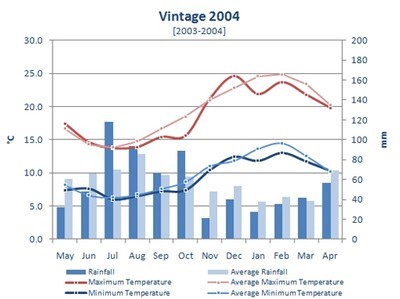
Main Ridge Pinot Noir
Budburst – 14 Sep
Flowering – 3 Dec
Veraison – 14 Feb
Harvest – 12 Apr
Budburst-harvest – 211 days
DORMANT INTERVAL [MAY – AUG]
Temperatures average; rainfall just above average. Even budburst.
BUDBURST INTERVAL [SEP – NOV]
Temperatures below average, particularly September and October, our coolest budburst interval; rainfall average. Our latest flowering (the only time flowering has occured in December).
FLORAISON INTERVAL [DEC – JAN]
Temperatures just below average but distorted by an above average December, one of our hottest, and below average January, our coolest; rainfall very low, 26% below average. Good fruit set.
VERAISON INTERVAL [Feb-Apr]
Temperatures well below average, our coolest veraison interval; rainfall just below average. Cool but dry led to late ripening but low disease pressure. Great flavour development with generous flavours throughout, excellent vintage.
Budburst 2nd latest after 2011, latest flowering (almost 2 weeks later than average), veraison a week later than average, harvest very late, 10 days later than average. Hang time 3 days longer than average.
Wines are regarded as excellent. Langton’s rate it 9/Halliday 10.
TASTING NOTES | 10X wines
TASTING NOTES | Estate/Reserve Wines
TASTING NOTES | Single Vineyard Wines
Journals/Newsletters
2005 Vintage
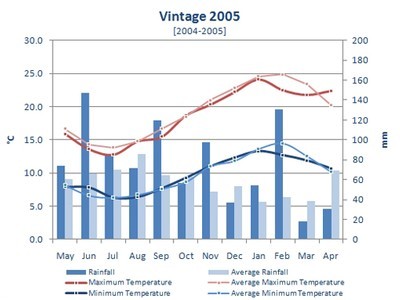
Main Ridge Pinot Noir
Budburst – 1 Sep
Flowering – 26 Nov
Veraison – 10 Feb
Harvest – 13 Apr
Budburst-harvest – 225 days
DORMANT INTERVAL [MAY – AUG]
Temperatures below average, our coolest dormant interval; rainfall 34% above average, our wettest dormant interval, though most in June (147mm v 66mm avg). Despite this, budburst almost a week earlier than average.
BUDBURST INTERVAL [SEP – NOV]
Temperatures slightly below average; rainfall 56% above average, both September and November had almost double their average (both the highest for those months in our records), our wettest budburst interval. Slow growth, with inflorescence development lagging.
FLORAISON INTERVAL [DEC – JAN]
Temperatures slightly below average; rainfall average. Cool weather conditions resulted in lower than average fruit set, smaller bunches with small berries.
VERAISON INTERVAL [Feb-Apr]
Temperatures average, below average February and March but well above average April; rainfall 26% above average but distorted by a very wet early February, our wettest in 11 years (131mm v 35mm avg; 3 February 2005 was our 2nd wettest day after the infamous 23 April 2001, 89mm in 24 hours). Grape maturities accelerated late into an extended ripening period with intense flavour development.
Budburst second earliest (with 2006, a week earlier than average), flowering and veraison just later than average, harvest 11 days later than average. Hang time 17 days longer than average, 2nd longest.
Wines are regarded as excellent. Langton’s rate it 9/Halliday 9.
TASTING NOTES | 10X WINES
TASTING NOTES | Estate/Reserve Wines
TASTING NOTES | Single Vineyard Wines
2005 McCutcheon Pinot Noir

Journals/Newsletters
2006 Vintage
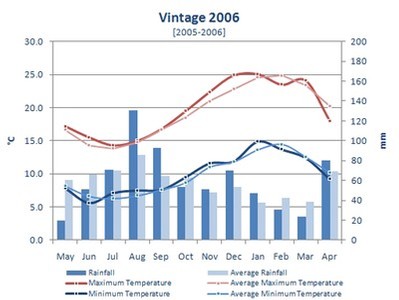
Main Ridge Pinot Noir
Budburst – 1 Sep [avg 7 Sep]
Flowering – 17 Nov [avg 21 Nov]
Veraison – 22 Jan [avg 3 Feb]
Harvest – 26 Mar [avg 31 Mar]
Budburst-harvest – 207 days [avg 207 days]
DORMANT INTERVAL [MAY – AUG]
Temperatures above average, our warmest dormant interval; rainfall average. Early budburst.
BUDBURST INTERVAL [SEP – NOV]
Temperatures above average, our 3rd warmest budburst interval; rainfall above average, most in September. Excellent flowering conditions.
FLORAISON INTERVAL [DEC – JAN]
Temperatures well above average, our 3rd warmest floraison interval; rainfall above average, our second wettest floraison interval. Good fruit set, average to above average yields.
VERAISON INTERVAL [Feb-Apr]
Temperatures below average, particularly February and April, our 2nd coolest veraison interval; rainfall just below average. Despite the cool February, March was warmer than average and dry and harvest was early with excellent vintage conditions, great fruit quality.
Budburst second earliest (with 2005, a week earlier than average), flowering early and veraison 2nd earliest in our records (2 weeks earlier than average), harvest 5 days earlier than average. Hang time average.
Wines are regarded as excellent. Langton’s rate it 9/Halliday 9.
TASTING NOTES | 10X WINES
TASTING NOTES | Estate/Reserve Wines
TASTING NOTES | Single Vineyard Wines
JOURNALS
2007 Vintage
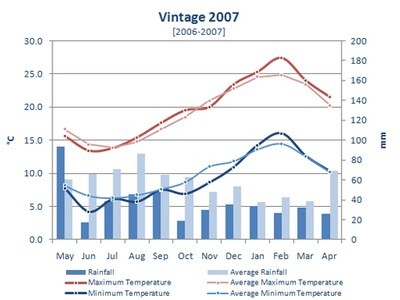
Main Ridge Pinot Noir
Budburst – 8 Sep [avg 7 Sep]
Flowering – 24 Nov [avg 21 Nov]
Veraison – 31 Jan [avg 3 Feb]
Harvest – 16 Mar [avg 31 Mar]
Budburst-harvest – 190 days [avg 207 days]
DORMANT INTERVAL [MAY – AUG]
Temperatures below average, particularly minimums – the coolest dormant interval minimums in our records; rainfall well below average, the driest dormant interval in our records. Despite this budburst only 1 day later than average. Budburst steady with slow spring growth.
BUDBURST INTERVAL [SEP – NOV]
Maximum temperatures above average but minimums well below average; rainfall well below average, 2nd driest budburst interval. Cool conditions led to long flowering period.
FLORAISON INTERVAL [DEC – JAN]
Temperatures above average; rainfall well below average. Fruit set low with yields well below average.
VERAISON INTERVAL [Feb-Apr]
Temperatures above average, our 3rd warmest veraison interval; rainfall well below average, our driest veraison interval (although rain event on 28 February saw 22mm). Harvest conditions excellent .
Our driest year (total 445mm v 673mm avg) and growing season (total 225mm v 353mm avg); annual maximum temperatures were above average but minimum temperatures were well below average during the budburst interval (frosts “down the hill” in October) affecting flowering and fruit set and therefore yield (2007 PN 2.3 t/ha).
Budburst and flowering about average, veraison a week early and harvest our 2nd earliest on record (for Pinot Noir), 15 days earlier than average. Hang time 17 days shorter than average (170 days v 207), the shortest in our records.
Wines are regarded as excellent. Langton’s rate it 8/Halliday 9.
TASTING NOTES | 10X WINES
TASTING NOTES | Single Vineyard Wines
JOURNALS
2008 Vintage
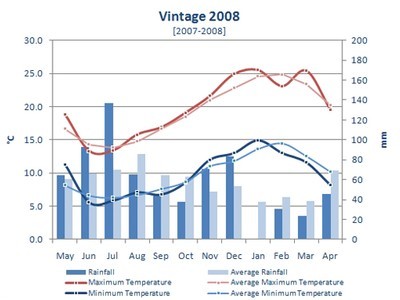
Main Ridge Pinot Noir
Budburst – 7 Sep [avg 7 Sep]
Flowering – 11 Nov [avg 21 Nov]
Veraison – 23 Jan [avg 3 Feb]
Harvest – 19 Mar [avg 31 Mar]
Budburst-harvest – 194 days [avg 207 days]
DORMANT INTERVAL [MAY – AUG]
Temperatures just above average; rainfall well above average (360mm v 282mm avg), 3rd wettest dormant interval. Good budburst, even growth.
BUDBURST INTERVAL [SEP – NOV]
Temperatures just above average; rainfall below average (though November above average). Excellent flowering period with high percentage set.
FLORAISON INTERVAL [DEC – JAN]
Temperatures well above average, our warmest floraison interval; rainfall below average.
VERAISON INTERVAL [Feb-Apr]
Temperatures average though this disguises our 2nd coolest February and warmest March (though minimums were below average throughout); rainfall below average. Right on harvest, the 10 days from 9-18 March saw 7 days above 30° with five of those above 35°. Excellent lead up to harvest although the 5 days above 35° caused concern, nevertheless flavours tracked well and fruit condition proved excellent.
Budburst and flowering about average, veraison 2 weeks early and harvest our 3rd earliest Pinot Noir on record, 12 days earlier than average. Hang time 13 days shorter than average, the 3rd shortest in our 14 year record.
Wines are regarded as very good. Langton’s rate it 8/Halliday 8.
TASTING NOTES | 10X WINES
TASTING NOTES | Single Vineyard Wines
JOURNALS
2009 Vintage
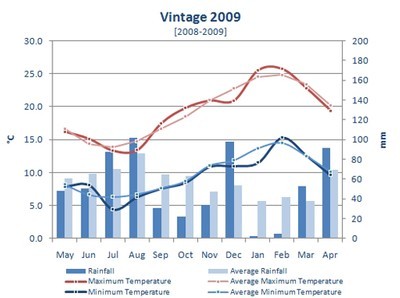
Description
Ironically, for a season that will be remembered for the devastation caused by the February 2009 bushfires, it was cool weather that defined the vintage “up the hill”. Budburst was excellent but in mid November, just as flowering commenced, through into December, cool wet weather meant flowering and fruit set was poor resulting in very low yields. Main Ridge was less effected by the intense heat from mid January to early February; the rolling hills tend to hide the vines from afternoon heat loads and our predominately east-west running rows were less exposed to the extreme afternoon heat which caused most damage. The end result was low yields, great balanced acidity and intense flavours.
Main Ridge Pinot Noir
Budburst – 11 Sep [avg 7 Sep]
Flowering – 15 Nov [avg 21 Nov]
Veraison – 6 Feb [avg 3 Feb]
Harvest – 6 Apr [avg 31 Mar]
Budburst-harvest – 208 days [avg 207 days]
DORMANT INTERVAL [MAY – AUG]
Temperatures around average, though cool July and August; rainfall average.
BUDBURST INTERVAL [SEP – NOV]
Temperatures above average; rainfall average. Slightly late budburst, good growth once started.
FLORAISON INTERVAL [DEC – JAN]
Temperatures slightly below average though cool December (2nd coolest) and very hot January (2nd highest); rainfall slightly above average though with a very wet December (51mm on 13th and 21mm on 14th creating some disease pressure) and very dry January. Cooler flowering period resulting in lower yields.
VERAISON INTERVAL [Feb-Apr]
Temperatures average though above average February (see below); rainfall average though driest February on record. Intense heatwave in February caused little interference with harvest “up the hill”.
Budburst slightly later than average, flowering a week earlier than average, veraison average and harvest 5 days later than average. Hang time average.
This was the year of the devastating Victorian bushfires. Over 20 days from 19 January to 7 February, Black Saturday, there were 9 days above 30° with 5 of those above 35° and 4 of those above 40°, culminating in 45.8° on Black Saturday.
Depending on several factors – row orientation, degree of leaf plucking – the effect of the heat ranged from relatively minor to significant with many bunches completely burnt on the west side of the rows and berries desiccated on the east side. Consequently quality is regarded as variable. Langton’s rate it 6/Halliday 9.
TASTING NOTES | 10X WINES
TASTING NOTES | Estate Wines
TASTING NOTES | Single Vineyard Wines
JOURNALS
2010 Vintage
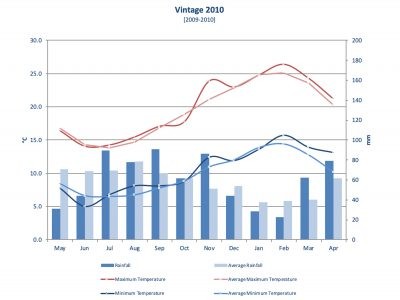
Description
2010 was a kind vintage beginning with good winter and spring rainfall, warm temperatures through August and September saw good budburst. Although October was marginally cooler than usual, November and December warmed up providing perfect conditions for the “Grand Growth” phase (a rapid growth phase which begins when the plant switches from vegetative to reproductive mode) and also for flowering and fruit set. February and March were warmer than average and the ripening period rolled along without any great concern, resulting in an early vintage with very high quality fruit.
Main Ridge Pinot Noir
Budburst – 7 Sep [avg 7 Sep]
Flowering – 14 Nov [avg 21 Nov]
Veraison – 27 Jan [avg 3 Feb]
Harvest – 20 Mar [avg 31 Mar]
Budburst-harvest – 195 days [avg 207]
DORMANT INTERVAL [MAY – AUG]
Temperatures above average; rainfall below average. Good budburst, even and consistent growth.
BUDBURST INTERVAL [SEP – NOV]
Temperatures above average including our warmest ever November; rainfall above average with the 3rd wettest November (40mm on 22nd). Excellent flowering period.
FLORAISON INTERVAL [DEC – JAN]
Temperatures just above average; rainfall well below average. Moderate disease pressure, good healthy canopies.
VERAISON INTERVAL [Feb-Apr]
Temperatures well above average; rainfall above average. Warm autumn although perfect harvest conditions and fruit picked at optimal flavours.
Budburst date average, flowering and veraison a week earlier than average and harvest 12 days earlier than average, our 4th earliest vintage. Hang time 2 weeks shorter than average, our 4th shortest.
Langton’s rate it 9 for Chardonnay, 10 for Pinot Noir/Halliday 9 for Chardonnay, 10 for Pinot Noir.
TASTING NOTES | 10X WINES
TASTING NOTES | Estate Wines
TASTING NOTES | Single Vineyard Wines
JOURNALS
2011 Vintage
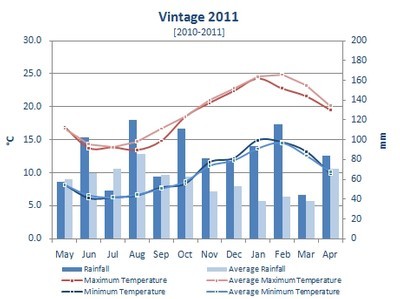
Description
After a decade of warm and dry conditions the 2011 vintage broke the drought with over 600 ml of rain during the growing season, the cool and wet conditions resulted in our latest harvest on record. A vintage characterised by never ending rain, cool temperatures (particularly around budburst and in the critical months from veraison to harvest) and high disease pressure. Some data…
- Melbourne’s wettest summer in 17 years and sixth wettest summer on record (306mm v average 163mm, record is 361mm 1903/04).
- Our average annual rainfall is 700 mm, in 2010/11 we received 999mm; our average growing season rainfall (Sep-Mar) is 353mm, in 2010/11 we received 588mm.
- Our average temperature from Feb-Apr is 22.7°C, in 2010/11 it was 21.3°C.
It was our latest ever budburst, almost 3 weeks later than average, flowering and veraison a little later than average and harvest 2 weeks later than average, our latest vintage. Hang time just shorter than average.
Yields were reduced but those grapes that were picked were of good quality – great natural acidity and lovely flavours in our Chardonnay with the Pinot Noir benefitting from the long cool ripening.
Main Ridge Pinot Noir
Budburst – 26 Sep [avg 7 Sep]
Flowering – 26 Nov [avg 21 Nov]
Veraison – 8 Feb [avg 3 Feb]
Harvest – 16 Apr [avg 31 Mar]
Budburst-harvest – 203 days [avg 207]
DORMANT INTERVAL [MAY – AUG]
Temperatures below average; rainfall above average, our 4th wettest dormant interval. Latest ever budburst (18 days later than average); even shoot length.
BUDBURST INTERVAL [SEP – NOV]
Temperatures below average; rainfall above average, our 2nd wettest budburst interval (including our wettest ever October). Long and humid flowering period resulting in good fruit set but with some hen and chicken.
FLORAISON INTERVAL [DEC – JAN]
Temperatures just above average; rainfall well above average (173mm v 91mm average), our wettest ever floraison interval including our wettest ever January (94mm v 36mm avg). High disease pressure period (Downy and Powdery Mildew), highest labour input required ever, good growth from humid and wet conditions.
VERAISON INTERVAL [Feb-Apr]
Temperatures cold; rainfall well above average (243mm v 151mm); equal 2nd longest veraison interval with 2001 (68 days v 57 day average). Constant triage to remove botrytis, low yields.
Budburst date latest ever, almost 3 weeks later than average, flowering and veraison a little later than average and harvest 2 weeks later than average, our latest vintage. Hang time just shorter than average.
Langton’s rate it 6 for Chardonnay, 5 for Pinot Noir/Halliday 6 for Chardonnay, 5 for Pinot Noir.
TASTING NOTES | 10X WINES
TASTING NOTES | Estate Wines
TASTING NOTES | Single Vineyard Wines
JOURNALS
2012 Vintage
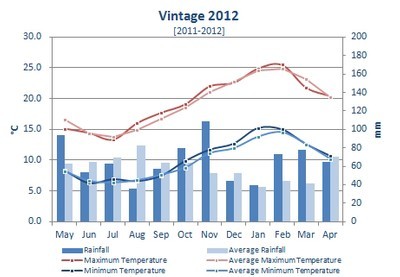
Description
A much more favourable season than 2011 though not without several interesting periods. Spring conditions were great for budburst and early season growth. With small bunches from the previous season’s cool and wet summer and a wet spell during flowering we saw moderate to low yields with highly concentrated flavours. An average budburst-harvest interval but our longest ever veraison-harvest interval (74 days v 57 day average) resulting in intensified flavour and colour development. Second longest difference between harvest in the lower north and the higher south (31 days v 17 day average).
Main Ridge Pinot Noir
Budburst – 31 Aug [avg 7 Sep]
Flowering – 12 Nov [avg 21 Nov]
Veraison – 16 Jan [avg 3 Feb]
Harvest – 26 Mar [avg 31 Mar]
Budburst-harvest – 208 [avg 207 days]
DORMANT INTERVAL [MAY – AUG]
Temperatures around average; rainfall below average (246mm v 280mm average).
BUDBURST INTERVAL [SEP – NOV]
Some disease pressure from above average rainfall (246mm v 181mm average including a very wet November, our wettest ever, 109mm, with several heavy falls, notably 38mm on 27th). Very warm, our equal warmest average maximum (19.6°C) and our 3rd warmest average minimum (9.7°C).
FLORAISON INTERVAL [DEC – JAN]
Rainfall was about average (84mm v 91mm average) as was maximum temperature (23.8°C v 23.7°C average), however, minimum temperatures were our equal warmest with vintage 2008 (14.0°C v 12.8°C average).
VERAISON INTERVAL [Feb-Apr]
Our longest veraison interval (74 days v 57 day average); February was warm with both minimums and maximums above average but March minimums were very low (21.8°C v 23.1°C average); April was close to average. February rainfall was well above average (73mm v 45mm) but this was largely due to the very heavy falls on one day, 41mm on the 28th; similarly March was above average (78mm v 41mm) with falls of 21mm on the 4th and 19mm on the 24th; April was slightly below average.
Budburst second earliest ever, a week earlier than average; flowering 9 days earlier than average and veraison our earliest ever, 19 days earlier than average; harvest was 8 days earlier than average, our 5th earliest vintage. Hang time was average.
Second longest difference between “up the hill” and “down the hill” – 31 days compared with an average of 17 days.
Langton’s rate it 9 for Chardonnay, 9 for Pinot Noir/Halliday 9 for Chardonnay, 9 for Pinot Noir.
TASTING NOTES | 10X WINES
TASTING NOTES | Estate Wines
TASTING NOTES | Single Vineyard Wines
JOURNALS
2013 Vintage
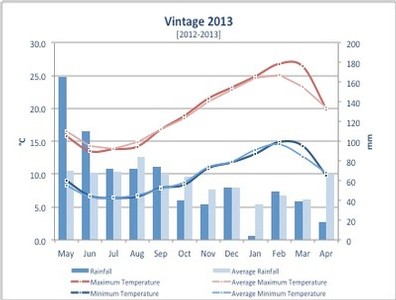
Description
After good winter rains the 2013 vintage ended as one of our driest and earliest vintages on record. The favourable weather throughout bud burst and flowering set up the ideal conditions for a very good vintage.
Main Ridge Pinot Noir
Budburst – 6 Sep [avg 6 Sep]
Flowering – 22 Nov [avg 21 Nov]
Veraison – 28 Jan [avg 3 Feb]
Harvest – 15 Mar [avg 30 Mar]
Budburst-harvest – 191 days [avg 206 days]
DORMANT INTERVAL [MAY – AUG]
Average length; lower than average maximum temperatures but slightly higher than average minimums; wettest ever dormant interval (420mm v 290mm average) with particularly wet May and June.
BUDBURST INTERVAL [SEP – NOV]
Average length; slightly below average rainfall and minimum temperatures but slightly above average maximum temperatures.
FLORAISON INTERVAL [DEC – JAN]
Shorter than average; above average maximum temperatures but slightly below average minimum temperatures; second lowest ever rainfall (57mm v 89mm average).
VERAISON INTERVAL [Feb-Apr]
Second shortest ever (47 days v 57 day average); highest ever maximum temperatures (25.9°C v 23.0°C) and minimums (14.6°C v 12.6°C), from 4-12 March we had nine days over 30°C, with three of those over 35°C; second lowest ever rainfall (89mm v 151mm average).
A vintage of extremes – wettest ever dormant interval and second driest floraison and veraison intervals; hottest ever veraison interval.
Langton’s rate it 9 for Chardonnay, 9 for Pinot Noir.
TASTING NOTES | 10X WINES
TASTING NOTES | Estate Wines
TASTING NOTES | Single Vineyard Wines
JOURNALS
2014 Vintage
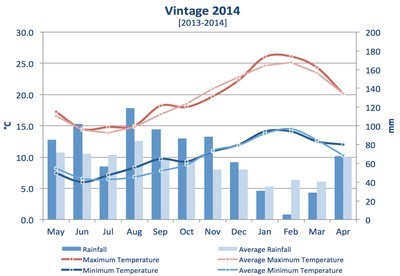
Description
The 2014 vintage was one of the lowest yielding on record. This was a result of the cold and wet conditions in mid November 2013 that seriously impacted fruit set during flowering. The cool, wet spring was followed by a warm and dry summer which, together with the low yields (our Pinot Noir and Chardonnay averaged 1.9t/ha or 0.8 t/acre), resulted in great concentration and flavour.
Main Ridge Pinot Noir
Budburst – 6 Sep [avg 7 Sep]
Flowering – 21 Nov [avg 20 Nov]
Veraison – 5 Feb [avg 2 Feb]
Harvest – 18 Mar [avg 28 Mar]
Budburst-harvest – 194 days [avg 204 days]
DORMANT INTERVAL [MAY – AUG]
One of our longest dormant intervals (174 days v 158 day average). Our third wettest and third warmest dormant interval.
BUDBURST INTERVAL [SEP – NOV]
Average length. Second wettest budburst interval; very wet November causing problems around flowering.
FLORAISON INTERVAL [DEC – JAN]
Average length.
VERAISON INTERVAL [Feb-Apr]
Our shortest veraison interval (42 days v 56 day average). Fourth driest and highest average maximum temperatures.
TASTING NOTES | 10X WINES
TASTING NOTES | Estate Wines
TASTING NOTES | Single Vineyard Wines
JOURNALS
2015 Vintage
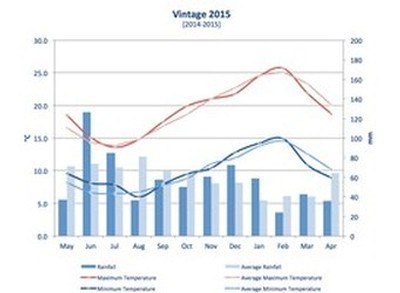
Description
Following heavy rainfalls in the winter, the 2015 growing conditions were exceptional. Mild and consistent temperatures over the summer and a cool and dry autumn produced beautiful fruit, balanced yields and healthy canopies. The resulting wines have bright fruit, great balance and persistence. One of our very best vintages. Yields were well up on the previous vintage (4.7t/ha or 1.9t/acre compared to 1.9t/ha or 0.8 t/acre).
Main Ridge Pinot Noir
Budburst – 12 Sep [avg 7 Sep]
Flowering – 21 Nov [avg 20 Nov]
Veraison – 28 Jan [avg 2 Feb]
Harvest – 22 Mar [avg 28 Mar]
Budburst-harvest – 192 days [avg 204 days]
DORMANT INTERVAL [MAY – AUG]
Second longest on record (18 days longer than average). Just below average rainfall, though with a very wet June (our second wettest, over 70% above average). Our warmest, maximum and minimum, dormant interval in 16 years.
BUDBURST INTERVAL [SEP – NOV]
Slightly shorter than average. Below average rainfall and above average temperatures (both minimum and maximum).
FLORAISON INTERVAL [DEC – JAN]
Slightly shorter than average. Above average rainfall (our 2nd wettest in 16 years) with below average maximum temperatures but above average minimum temperatures.
VERAISON INTERVAL [Feb-Apr]
Average length. One of our driest veraison intervals with rainfall 30% below average. Below average minimum and maximum temperatures in March but this was not until the end of the month after harvest.
TASTING NOTES | 10X WINES
TASTING NOTES | Estate Wines
TASTING NOTES | Single Vineyard Wines
JOURNALS
2016 Vintage
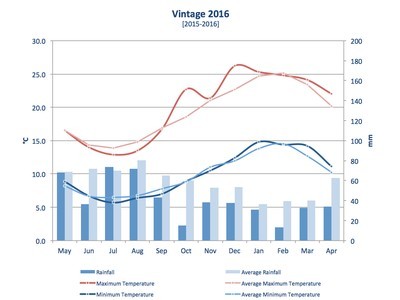
Description
A vintage of records…
- Highest average maximum temperature (23ºC v 21.8ºC avg)
- Lowest growing season rainfall (211mm v 348mm avg)
- Shortest hang time (budburst-harvest; 21 days shorter than average)
- Earliest flowering date (10 days earlier than average)
- Earliest harvest (23 days earlier than average)
So, a very dry, warm year with down-the-hill all picked before the end of February and up-the-hill picked by the first week of March – both unprecedented. Quality looks excellent.
Main Ridge Pinot Noir
Budburst – 5 Sep [avg 6 Sep]
Flowering – 11 Nov [avg 20 Nov]
Veraison – 17 Jan [avg 2 Feb]
Harvest – 6 Mar [avg 28 Mar]
Budburst-harvest – 183 days [avg 204 days]
DORMANT INTERVAL [MAY – AUG]
Slightly longer than average; coolest average maximum temperature (14.2ºC v 14.9ºC avg).
BUDBURST INTERVAL [SEP – NOV]
Slightly shorter than average; second driest budburst interval; warmest average maximum temperature (20.3ºC v 18.8ºC avg).
FLORAISON INTERVAL [DEC – JAN]
Slightly shorter than average; warmest average maximum temperature (25.8ºC v 23.7ºC avg).
VERAISON INTERVAL [FEB – APR]
Slightly shorter than average; warmest average maximum temperature (25.8ºC v 23.7ºC avg).
TASTING NOTES | 10X WINES
TASTING NOTES | Estate Wines
TASTING NOTES | Single Vineyard Wines
JOURNALS
2017 Vintage
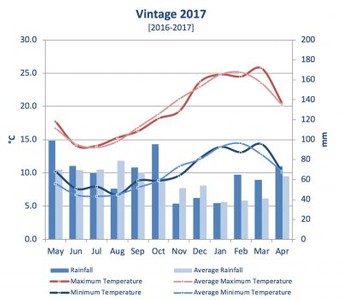
Description
Following an average rainfall and relatively warm winter, it was again the spring weather leading up to flowering which caused issues. October was our third wettest on record (96mm v 62mm average) and November saw our second coldest maximum and minimum temperatures (19.3° v 20.9°, 9.6° v 10.9°), consequently the budburst interval (budburst-flowering) was our longest ever – 87 days v an average of 75 days – and flowering was our latest ever (5 December v our 21 November average). In the end, due to the excellent February and March, hang time (budburst-harvest) was average – 205 days v an average of 203 days – and harvest date was close to average – 1 April v an average of 28 March. Yields were down because of the problems around flowering but summer and early autumn saw long, slow ripening – perfect for our Pinot Noir and Chardonnay.
Key Dates (Main Ridge Pinot Noir Dates for 2016/17)
Budburst – 9 Sep (avg 7 Sep)
Flowering – 5 Dec (avg 21 Nov)
Veraison – 6 Feb (avg 1 Feb)
Harvest – 1 Apr (avg 28 Mar)
Budburst-Harvest – 205 days (avg 203 days)
Up v Down Difference – 18 days (avg 17 days)
TASTING NOTES | 10X WINES
TASTING NOTES | Estate WINES
TASTING NOTES | Single Vineyard Wines
2018 Vintage
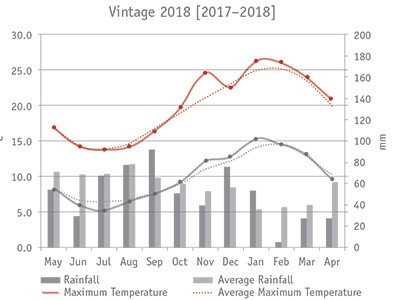
Description
The 2018 vintage began with heavier than normal winter rains and cooler temperatures which delayed budburst (our second latest, 20 September compared to an average 7 September) but warmer spring weather resulted in perfect conditions for flowering (24 November, around the average of 21 November) leading to very good fruit set and promising high yields. In fact, particularly down the hill, crop adjustment was required to ensure even maturity and high quality outcomes.
Key Dates (Main Ridge Pinot Noir Dates for 2017/18)
Budburst – 20 Sep (avg 7 Sep)
Flowering – 24 Dec (avg 21 Nov)
Veraison – 24 Jan (avg 1 Feb)
Harvest – 17 Mar (avg 28 Mar)
Budburst-Harvest – 179 days (avg 203 days)
Up v Down Difference – 18 days (avg 17 days)
TASTING NOTES | 10X WINES
TASTING NOTES | Estate WINES
TASTING NOTES | Single Vineyard Wines
2019 Vintage
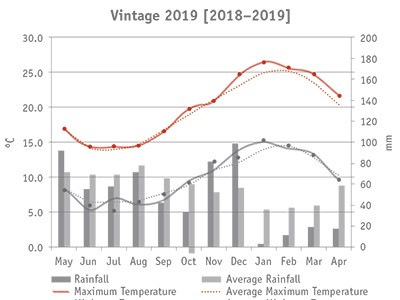
Description
Following a lower than average rainfall and relatively standard temperatures over the winter, cooler temperatures in August and September led to late budburst (our second latest) and flowering (fourth latest).
However, above average temperatures and low rainfall during summer meant an early veraison and harvest (our second earliest). The period between flowering and veraison saw our warmest ever average minimums and second warmestmaximums and was our second shortest(62 days against a 72 day average). Veraison to harvest was our fourth warmest (maximums) and our driest (47mm v 136mm average) and our third shortest (43 days against a 56 day average).
Key Dates (Main Ridge Pinot Noir Dates for 2018/19)
Budburst – 20 Sep (avg 8 Sep)
Flowering – 28 Nov (avg 22 Nov)
Veraison – 29 Jan (avg 1 Feb)
Harvest – 12 Mar (avg 27 Mar)
Budburst-Harvest – 174 days (avg 201 days)
Up v Down Difference – 13 days (avg 17 days)
TASTING NOTES | 10X WINES
TASTING NOTES | Estate WINES
TASTING NOTES | Single Vineyard Wines
2020 Vintage
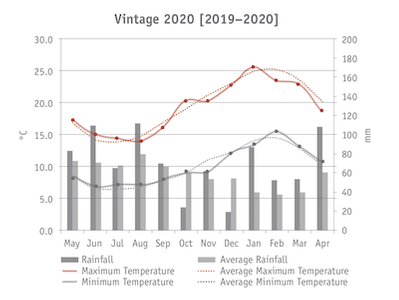
Description
Lower than average rainfall and relatively standard temperatures over winter and cooler temperatures over spring led to late budburst and flowering (our latest on record). A cold start to the summer delayed fruit set and reduced yields.
This was followed by mild conditions over autumn 10.0 providing slower ripening and resulting in a later start to the vintage (2 weeks later than average).
Although yields were reduced, grapes that were picked were of good quality – great natural acidity and lovely flavours in our Chardonnay with the Pinot Noir benefitting from the long cool ripening.
Key Dates (Main Ridge Pinot Noir Dates for 2019/20)
Budburst – 29 Sep 2019 (latest ever)
Flowering – 12 Dec 2019 (latest ever)
Veraison – 7 Feb 2020 (close to average)
Harvest – 28 Mar 2020 (Average)
Hang time – 181 days (third shortest)
Up v Down Difference – 15 days (avg 17 days)
TASTING NOTES | 10X WINES
TASTING NOTES | Estate WINES
2021 Vintage
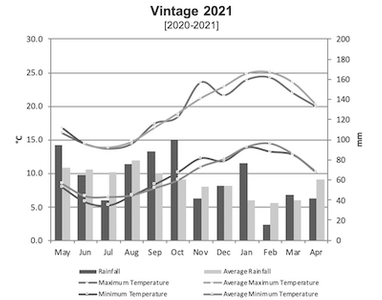
Description
Moderate temperatures throughout a wet spring and throughout flowering resulted in healthy canopies with slightly lower than average yields. Above average rainfall over the Summer due to La Niña was moderated by dry spells and moderate temperatures resulted in slower ripening. High levels of acidity were retained together with great concentration of flavour and fine detail.
Key Dates (Main Ridge Pinot Noir Dates for 2020/21)
Budburst – 17 Sep 2020 (av 8 Sep)
Flowering – 23 Nov 2020 (av 22 Nov)
Veraison – 30 Jan 2021 (av 1 Feb)
Harvest – 29 Mar 2021 (av 27 Mar)
Hang time – 193 days (av 201 days)
Up v Down Difference – 14 days (avg 17 days)
TASTING NOTES | 10X WINES
TASTING NOTES | Estate WINES
TASTING NOTES | Single Vineyard Wines
2022 Vintage
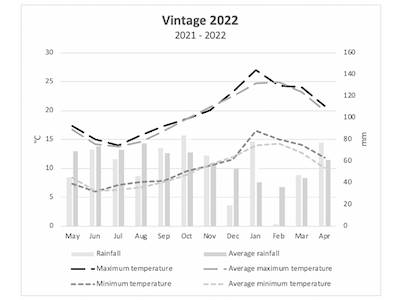
Description
The 2022 season started with a very wet and variable spring, resulting in poor flowering, small bunches and reduced yields across many sites. However, the exceptional summer and autumn months to follow provided perfect ripening conditions that generated great concentration and striking flavours across all varieties.
Key Dates (Main Ridge Pinot Noir Dates for 2021/22)
Budburst – 23 August 2021 (av 6 Sep)
Flowering – 12 Nov 2021 (av 20 Nov)
Veraison – 12 Jan 2022 (av 5 Feb)
Harvest – 22 Mar 2022 (av 27 Mar)
Hang time – 185 days (av 201 days)
Up v Down Difference – 15 days (avg 17 days)
TASTING NOTES | 10X WINES
TASTING NOTES | Estate WINES
2023 Vintage

Description
The 2023 season started with a very wet and variable spring, resulting in poor flowering, small bunches and reduced yields across many sites. However, the exceptional summer and autumn months to follow provided perfect ripening conditions that generated great concentration and striking flavours across all varieties.
Key Dates (Main Ridge Pinot Noir Dates for 2022/23)
Budburst – 3/9/22 – 19/9/22 ( av 6/9)
Flowering – 1/11/22 – 10/12/22 (Av 29/11)
Veraison – start 18/1/23 – 3/2/23 to finish 2/2/23 – 10/2/23
Harvest – 16/3/23 – 14/4/23
Hang time – Average 210 days
Up v Down Difference – 23 days
TASTING NOTES | 10X WINES
TASTING NOTES | Estate WINES
2024 Vintage
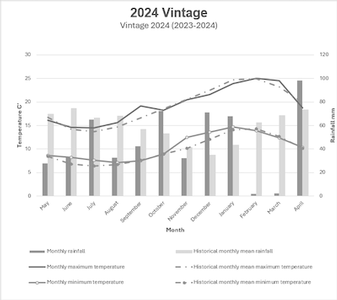
Description
After a wet spring, the 2024 season gave ample sunlight and ideal ripening conditions across all varieties. Phenological ripeness was uniform and flavours although delayed, were abundant in great concentrations.
Key Dates (Main Ridge Pinot Noir Dates for 2023/24)
Budburst –
Flowering –
Veraison –
Harvest –
Hang time – Average
Up v Down Difference –
TASTING NOTES | 10X WINES
2024 10X Pinot Gris

2024 10X Rose

TASTING NOTES | Estate WINES
2024 Estate Riesling

2024 Estate Chardonnay

2024 Estate 'Down the Hill' Pinot Noir

2024 Estate 'Up the Hill' Pinot Noir

























